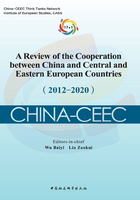
2. China-CEEC Economic, Trade and Investment Cooperation: Highlights in China-EU Economic Relations
Since the establishment of China-CEEC Cooperation, China-CEEC economic cooperation and trade has produced fruitful results, with two-way trade steadily growing and becoming a highlight in China-EU economic relations. We have seen constantly improved bilateral cooperation mechanisms, expanded mutual investment and smooth infrastructural cooperation, and China-CEEC investment cooperation in the infrastructure, energy and manufacturing sectors have significantly contributed to China-EU economic and trade ties, as evidenced in the following three aspects:
First, economic and trade cooperation mechanisms have been improving. The China-CEEC Ministerial Conference on Economic and Trade Promotion, the Business Forum, the Investment Promotion Agencies Contact Mechanism, the Business Council and the SME Coordination Mechanism were established under the China-CEEC Cooperation framework. Meanwhile, the China-CEEC Investment and Trade Expo and the China International Import Expo have become important avenue for CEECs to promote their quality products in China, significantly raising the awareness of Chinese customers towards CEEC products. Bilaterally, China established working groups on trade promotion with Romania and Hungary and working groups on e-commerce and investment cooperation with Estonia and Croatia. Multilaterally, trade mechanisms under the China-CEEC framework play a complementary role in China-EU trade relations. Take the China-CEEC SME Coordination Mechanism for example. It takes into full account the share of SME in CEEC economies and its importance in creating jobs and enhancing competitiveness and aims to step up SME cooperation and exchanges between China and CEECs. From 2018 to 2019, two China-CEEC Forums on SME Cooperation were held in Cangzhou, Hebei Province, where multiple cooperation projects were agreed on, with a total value of over 16 billion RMB yuan. Besides, a China-CEEC SME Cooperation Zone was established in 2018[11], and efforts have been made to put in place a China-CEEC research findings commercialization base, an industrial cooperation base, a CEEC products presentation and trade base and a cultural exchanges center. Since 2015, the China-CEEC Investment and Trade Expo has been organized in Ningbo. The Expo has since become an important platform related to trade and investment between China and the EU, offering CEECs a useful opportunity to present their products. In fact, most CEEC businesses are associated with the EU in one way or another, and their trade with China is an important part of China-EU trade. Therefore, the above-mentioned China-CEEC mechanisms have helped advance China-EU business ties.
Second, two-way trade has been steadily growing. According to Chinese Customs statistics, China-EU trade stood at 705.1 billion US dollars, up by 3.4% year-on-year, making the EU the largest trading partner of China’s for 16 consecutive years.[12] As mentioned earlier, the share of China-CEEC trade in China-EU trade showed a trend of growth in 2019, as China-CEEC trade has been growing year by year, at a rate faster than that of China-EU trade, making it a new driver for China-EU trade. CEECs have a unique advantage and a special role to play in promoting China-EU trade. By taking advantage of China-CEEC Cooperation, CEECs are well positioned to become a hub connecting China with the European high-end market and its advanced industrial capacity. CEECs are also able to make use of the spill-over effect of the fast growth of the Chinese economy to help upgrade their own industries and improve people’s livelihood. The constantly improving industrial chain among China, CEECs and the EU as a whole has helped develop various sectors in Europe and narrow the economic and social gap between CEECs and other more advanced parts of Europe. In addition, the years since the inception of China-CEEC Cooperation have seen rapid growth in the number of Chinese tourists in CEECs. According to Chinese statistics, more than six million Chinese tourists visited Europe in 2018, out of which 36.3% visited eastern Europe, ranking the first among all parts of Europe, higher than western Europe (32.8%), the Nordic states (16.6%) and southern Europe (14.2%). In the first half of 2019, the number of Chinese tourists visiting CEECs grew by three to five times. [13] The immense attraction of CEECs to Chinese tourists have been translated into important impetus for economic cooperation and trade between China and CEECs. Despite a surplus in trade in goods on the part of China towards most CEECs and the EU, there has been a clear surplus on the part of CEECs and the EU when it comes to tourism.
Third, mutual investment has been expanding. As China-CEEC Cooperation deepens, China’s investment in CEECs has been growing rapidly, with bigger share in China’s total investment in Europe and total foreign direct investment. Although Chinese investment is becoming less concentrated in certain CEECs, distribution among regional countries has been improved. In 2018, Chinese direct investment stock in the 17 CEECs was 2.512 billion US dollars in 2018, up by nearly 20% over 2017, much faster than China’s total FDI stock growth. The investment is largely made in machinery manufacturing, chemicals, finance, environmental protection, logistics and new energy sectors. Mutual investment has brought about cooperation on industrial capacity, a new driving force for China-EU business cooperation. In 2018, EU investment in China stood at 10.42 billion US dollars in real terms, up by 25.7% over the previous year, while Chinese direct investment in the EU stood at 8.11 billion US dollars, up by 7.1%.[14] As China and CEECs continue to upgrade their relations and the CEECs continue to improve their business environment, China’s direct investment has been accumulated to a certain extent, and China-CEEC Cooperation has gradually become a highlight in China’s business ties with the EU and the world as a whole.
In the context of difficult times for European integration and Brexit, it is important to strengthen China-CEEC Cooperation, as it will surely help China and the EU in their joint efforts to uphold multilateralism, oppose trade protectionism, increase mutual investment and trade and step up cooperation in global economic governance.